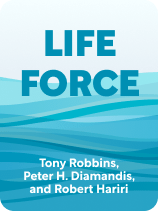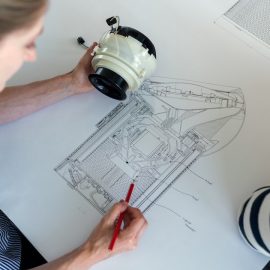

This article is an excerpt from the Shortform book guide to "Life Force" by Tony Robbins, Peter H. Diamandis, and Robert Hariri. Shortform has the world's best summaries and analyses of books you should be reading.
Like this article? Sign up for a free trial here.
What is Tony Robbins’s Life Force about? What is the key message to take away from the book?
In their book Life Force, Tony Robbins and his co-authors Peter Diamandis and Robert Hariri highlight the actions you can take to improve your health. They also describe a number of up-and-coming technologies that have the potential for incredible health achievements.
Below is a brief overview of Life Force: How New Breakthroughs in Precision Medicine Can Transform the Quality of Your Life & Those You Love.
Life Force: How New Breakthroughs in Precision Medicine Can Transform the Quality of Your Life & Those You Love
In their book Life Force, Tony Robbins and his co-authors Peter Diamandis and Robert Hariri show you how to take advantage of the latest research and technology to maximize your physical health and increase your lifespan and healthspan.
In their book Life Force, Tony Robbins and his co-authors Peter Diamandis and Robert Hariri highlight the actions you can take to improve your health, including making healthy lifestyle choices and taking steps to catch diseases early. They also describe a number of up-and-coming technologies that have the potential for incredible health achievements, including providing a cure for the negative effects of aging.
Robbins is a bestselling author, speaker, investor, and philanthropist whose other works include Awaken the Giant Within, Money, and Unlimited Power. He has coached world-famous athletes and other public figures, including four US presidents, and he has founded or invested in over 100 businesses. Peter Diamandis is a bestselling author of such works as Bold and Abundance. He has a medical degree from Harvard, a degree in molecular genetics, and another in aerospace engineering. Robert Hariri is a neurosurgeon and scientist. Both Diamandis and Hariri are co-founders of Human Longevity and Celularity, companies that use technology to create better health outcomes.
In our guide, we’ll discuss the authors’ recommendations on how to improve your health to proactively prevent future ailments. We’ll then describe the technologies available to us now and the ones that may become available in the future to find and prevent disease and to reverse aging. We’ll also elaborate on some of the authors’ more complex ideas, and we’ll contextualize the guide’s information in the fields of science, technology, and sociology.
Take Charge of Your Health Today
Robbins, Diamandis, and Hariri explain that we are currently seeing an ongoing revolution in the field of healthcare, specifically regenerative medicine. As our technology and knowledge continue to advance, we have the ability to take charge of our own health and extend not only our lifespans but also our healthspans—the portion of our lives during which we are healthy and can enjoy a high quality of life. The authors encourage you to take advantage of the resources at your disposal to optimize your current health and maintain it throughout a long and satisfying life. In the coming sections, we’ll look at some of those resources.
Nourishing Your Body: The Importance of a Healthy Diet
Robbins, Diamandis, and Hariri explain that the best way to prevent disease is by living a healthy lifestyle, but there is a great deal of conflicting information available about how to make healthy choices. The authors say that it’s critical to have correct knowledge of what’s healthy to lead a good lifestyle. They offer some tips for how to be healthier, beginning with establishing and maintaining a healthy diet.
Dietary Needs and Food Availability
Robbins, Diamandis, and Hariri also point out that many of our dietary needs depend on our ancestry and that we should personalize our diets according to these needs. As humans evolved, groups of people lived in areas where only certain foods were available, so their microbiomes—the combination of bacteria, viruses, and microbes that inhabit our digestive tracts and influence our metabolism—evolved to be better at metabolizing certain foods than they were at others. The authors recommend having your gut’s microbiome tested to see what foods are the best for your personal health.
The authors acknowledge that much of our diet consists of the foods that are readily available to us—as opposed to foods that are best for us based on our ancestry or foods considered universally healthy. They explain that more and more of the foods we’re being sold are ultra-processed foods that are often marketed as healthy (foods like granola bars and fruit juices). However, these foods are associated with an increased risk of high blood pressure, heart disease, cancer, and diabetes.
Additionally, the average American diet features excesses of sugar, meat, fat, and sodium, and consists of too many calories in general. The authors recommend cutting out refined carbohydrates, sugary drinks and foods, red meat, processed meat, and dairy and replacing them with fruits, vegetables, legumes, fish, and whole grains.
Diabetes and Obesity
In discussing diet, the authors place special emphasis on diabetes and obesity, saying that obesity and diabetes are not only preventable but reversible. They point out that nearly three-quarters of Americans over 19 are overweight and that over 40% of American adults are obese. Obesity greatly increases the risk of many different diseases, such as diabetes, stroke, asthma, and Alzheimer’s, and it was shown to be the second most important risk factor of death from COVID between 2020 and 2021—second only to age.
Additionally, approximately 10% of Americans have diabetes, and these numbers are expected to grow in the future. (The authors note that the CDC uses the body mass index scale to measure whether someone is overweight or obese, but they point out that this scale is flawed as it fails to account for factors like bone density, muscle mass, and race.)
To combat these diseases, the authors recommend such measures as reducing your calorie intake. They note that cutting out just 300 calories per day can reduce body fat and provide other benefits like reduced inflammation and blood pressure, better sleep, and more energy. Additionally, research suggests that losing 20-30 pounds in a short period of time can actually reverse type 2 diabetes.
Fasting
According to the authors, fasting is a helpful tool in both weight loss and fighting disease. Fasting gives your body a break from digestion and shifts your metabolic state from burning sugar for energy to burning fat. They list a number of fasting methods, including establishing a specific time period each day during which you eat and then fasting the rest of the time—anywhere from 12 to 16 hours per day. This could be accomplished by skipping breakfast and only eating between noon and 8 pm, for example. Another method involves heavily restricting your calories two days a week and eating normally the other five.
The Importance of Exercise
Robbins, Diamandis, and Hariri recommend moderate to vigorous exercise for maintaining a healthy lifestyle. They explain that sedentary lifestyles—those that involve sitting for six or more hours per day with little to no exercise—put you at much higher risk for many different causes of premature death. Exercising regularly can reduce the risk of heart disease, kidney disease, diabetes, dementia, and various types of cancer. However, they also point out that too much exercise can result in injury or cause you to burn out. They recommend making simple lifestyle changes that provide you with your personal optimal level of activity.
For example, simple changes such as walking for two and a half hours a week can drastically reduce your risk of dying from a stroke or heart attack. These benefits increase if you choose a harder activity such as jogging, which can reduce your biological age by nearly a decade. (Your biological age is how old your body appears to be based on the condition of your cells and tissues—as opposed to chronological age, which is how many years you’ve been alive.)
The authors also counsel you to build muscle mass, which improves your metabolism and decreases the risk of falling as you age. They recommend static contraction exercises, which involve holding the maximum weight you can hold in a still position for several seconds. They also point out that rest is vital to building muscle, and that it’s necessary to give your muscles a few days of rest after exercising them intensely in order to get stronger.
Sleep: Refreshing Your Body
The authors explain that sleep is an integral part of our overall health and that you should take steps to optimize it. They cite Matthew Walker, a sleep specialist who says sleep may be the single most important factor in a healthy lifestyle. Long-term sleep deprivation impairs the body’s ability to regulate its blood glucose levels, leading to a higher risk of diabetes, and it can also cause hypertension and greatly weaken your immune system. Additionally, it can increase the risk of dementia and mental illnesses such as depression, and it can even interfere with our hormones and sex drive.
The authors share Walker’s advice on how to make sure you’re getting enough sleep, starting with figuring out if you are. If you still feel the need to sleep after your alarm goes off in the morning, or you find yourself sleeping a lot more on the weekends to pay off the sleep debt you’ve built up during the week, you may not be getting enough sleep on a regular basis.
If your level of sleep deprivation seems severe, you should consult a doctor, but otherwise, you can improve your sleep by going to bed at the same time every night, keeping the temperature in your bedroom between 65 and 67 degrees Fahrenheit, cutting your caffeine intake, and avoiding too much light stimulation near bedtime—for example, by refraining from watching television or scrolling on your phone. Also, make sure you’re setting aside enough time to get a full night’s sleep. If you know you need eight hours of sleep, but you also know you tend to wake up once or twice during the night, be sure to take that into account when setting your bedtime and alarm.
Walker also says part of the reason sleep deprivation is so common is that people associate sleep with laziness and glorify sleep deprivation as a sign of a strong work ethic. This is particularly true in rich nations such as the United States, where eight in 10 people are sleep deprived, and Japan, where the statistic is nine in 10.
The Benefits of Heat and Cold
The authors also advise using heat therapy and cold therapy as a way to prevent the onset of disease and pain.
For heat therapy, they recommend using a sauna for about 20 minutes a few times a week at a temperature of 163 degrees Fahrenheit, noting that it reduces the risk of premature death from all causes by 40%. It also reduces the risk of heart disease, dementia, arthritis, depression, and stroke.
For cold therapy, they recommend whole-body cryotherapy, which involves spending just two or three minutes in a chamber filled with gas as cold as negative 240 degrees Fahrenheit with almost no clothing. This provides a shock to the system that dramatically reduces pain and inflammation. The authors also say that you can use ice plunges if you don’t have access to a cryotherapy chamber. This involves submerging your body in ice water for two minutes and achieves some of the same results as whole-body cryotherapy.
Diagnostic Testing: Catching Illnesses Early
In addition to their tips for a healthy lifestyle, the authors explain how diagnostic testing can help you prevent illnesses or catch them at the early stages when they are most treatable. They recommend several tests, including one for heart disease and one for cancer, and they also recommend testing your hormones and levels of heavy metals in your blood. Let’s look at these different tests.
The authors recommend you get a coronary computed tomography angiography, or CCTA, a type of heart scan that shows plaque in your arteries. A new method of this testing created by a company called Cleerly uses artificial intelligence to distinguish between types of plaque, some of which are more harmful than others and can be early indicators of heart disease.
The authors also recommend a yearly full-body MRI combined with a comprehensive blood test to detect cancer, noting that the survival rate for early-detected cancer is nearly 90% while the survival rate for late-detected cancer is just over 20%. The blood test they recommend is called Galleri, developed by a company called GRAIL. Prior to the development of this test, we were only able to detect a few types of cancer before they began causing problems in a patient’s system, but this test can detect more than 50 different types of cancer, and the handful of types it can’t detect—such as brain or kidney cancer—can be detected with a full-body MRI.
You should also get your blood tested to assess your hormone levels and the presence of heavy metals in your blood. Testing your hormones annually can help you identify and compensate for irregularities through hormone replacement therapy or hormone optimization therapy.
Hormones are key to numerous bodily functions, but hormone levels begin to drop in early middle age. This negatively impacts your energy levels, your muscle mass, your fertility, your physical appearance, your blood sugar, your body’s inflammatory response, and your ability to concentrate, among many other things.
Finally, you should test your blood for toxic metals such as mercury, which can cause memory issues, exhaustion, and ultimately death. Fish often contain mercury, and if you have a diet high in fish you may be at increased risk for mercury poisoning.
Tapping Into Your Body’s Defenses With Medical Technologies
Your body is born with an array of natural defenses against illness and injury, but these defenses can weaken with age or as a result of mutations. Making healthy lifestyle choices helps keep these defenses strong, but our advancing technology offers other ways to enhance them as well. Let’s look at some of these technologies.
Immunotherapy to Target Cancer Cells
The authors explain that a new immunotherapy treatment called CAR T cell therapy helps our immune systems better target cancer cells. Your body’s immune system is your number one defense against illness. A young, healthy immune system uses T cells to detect and fight off viruses, infections, and precancerous cells, but as we age our immune systems become weaker and more susceptible to these attackers. This can lead to increased susceptibility to illness in general, but it especially increases the risk for autoimmune diseases like leukemia.
CAR T cell therapy allows us to reinforce our immune systems through personalized medicines that direct the body’s defenses to attack cancer cells with a precision that other cancer treatments like chemotherapy don’t have. CAR—or chimeric antigen receptor—T cells are modified immune cells made from a patient’s own tissues. CAR T cell therapy is extremely effective in fighting leukemia—a liquid cancer—but it has little impact on solid cancers, which are the cause of nine out of ten deaths from cancer in the US.
Gene Therapy to Cure Genetic Diseases
The authors also discuss a cure for genetic diseases called gene therapy. Gene therapy is a process that uses viruses to replace mutated, illness-causing DNA in the body’s cells with healthy DNA. The injected virus containing the healthy DNA attaches itself to the patient’s cells and causes them to start replicating that healthy DNA, eliminating the mutation that was causing the disease.
Another type of treatment using genes is gene editing, which allows scientists to edit DNA within cells. An editing protein called CRISPR-Cas9 locates the DNA that needs to be edited and snips out the portion of it that’s causing problems. Its ability to locate the affected DNA also makes it an excellent diagnostic tool for rapidly detecting diseases, including cancer and viral infections such as COVID-19. Gene editing is a newer technology than gene therapy, and research is underway to discover more editing proteins to expand our options in what diseases we treat and how.
Stem Cell Therapy to Reverse Aging
The authors explain that we can use stem cell therapy to essentially rebuild our bodies. Stem cells are cells that can turn into any type of cell according to the body’s needs and can then continue to replicate themselves. They can repair damaged tissue and strengthen your immune system. As we age, we begin to exhaust our supply of stem cells. When injected, stem cells can replace older, damaged cells and reduce our biological age.
One method of stem cell therapy involves extracting a patient’s own stem cells from their adipose tissue or bone marrow. However, the authors explain that this method is invasive and unreliable. They instead highlight placental stem cells, those derived from fresh placentas after a healthy birth. These cells are of the highest quality because they haven’t been exposed to toxins or damage from UV rays or tobacco and because they include supercharged immune cells that fight cancer. Unfortunately, they have yet to receive FDA approval. Robbins explains how three days of treatment with stem cells from umbilical cords—which he describes as second-best to placental stem cells—cured him of back pain that had plagued him for 14 years.
Methods to Eliminate and Manage Pain
The authors discuss several methods of pain management, some of which helped Robbins deal with his own pain, which included decades of back and spinal issues, a torn rotator cuff, and intense growth pains from an overactive pituitary gland.
Robbins explains one of the most effective techniques he found for pain relief is a technology called pulsed electromagnetic field therapy, or PEMF. This involves delivering electrical pulses to the body using a specialized machine to stimulate the body’s natural healing abilities. Robbins says the machine also helps with his sleep and energy levels, and he found it so beneficial that he purchased his own machine to use every day.
The authors also recommend postural therapy, a type of physical therapy designed to restore alignment to the body as a way to treat injuries and chronic pain. They specifically discuss the Egoscue Method, a set of exercises developed by Vietnam War veteran Pete Egoscue to treat the severe nerve pain he incurred from his combat wounds. These exercises take just a few minutes and focus on keeping your body balanced and your posture in alignment.
Additionally, the authors discuss a therapy called counterstrain that involves repositioning the body to target inflammation and relax the body’s overactive protective reflexes. This therapy can treat not only inflamed muscle, but also organs, nerves, and even bone. It’s performed by a practitioner who massages the body to find trigger points, then manually stimulates those trigger points to release inflammation. It differs from massage in that it focuses on the source of the inflammation instead of just the muscle pain that results from inflammation.
Ongoing Innovations in Regenerative Medicine
Robbins, Diamandis, and Hariri also investigate some innovations that are currently underway that could revolutionize the medical field and help reverse aging. This includes technology that uses the body’s pathways to direct cell production, a company that’s working towards growing human organs for transplantation, artificial intelligence technology that could create personalized drugs, and microscopic robots that can be deployed into a person’s body to fight disease head-on.
Using the Body’s Wnt Pathway
The authors explain how a company called Biosplice is working on using a natural biochemical pathway in the body called the Wnt signaling pathway to essentially reverse aging by restoring any part of the body that’s damaged. This pathway tells your stem cells to make new cells and tissue that physically replenish your body. As we age, our Wnt signaling pathway becomes distorted by toxins and poor lifestyle choices, and our stem cells start producing too much of some tissues and too little of others, resulting in illness.
Biosplice is creating medicinal molecules that interact with this pathway to tell specific stem cells to create more or less tissue based on what the body needs and restore the body’s natural balance. Phase 3 trials for their drug Lorecivivint as treatment for osteoarthritis are currently underway.
Growing Human Organs
According to the authors, a company called United Therapeutics is working toward the ability to grow and 3D-print organs for transplantation. They note that there are over 100,000 people in America currently waiting for an organ transplant and that most of them will never get one. Scientists are currently working on using pigs—a species whose organs happen to be of similar size and shape to humans’—to replicate organs for humans, and they’re using CRISPR gene editing technology to edit the organs’ genes so that they won’t be rejected if transplanted into a human host.
However, since organs can still be rejected long after transplantation—resulting in recipients having to take immunosuppressants for the rest of their lives—the company is also working toward growing organs from scratch from a patient’s own cells so there would be no risk of rejection and no need for immunosuppressants.
Creating Personalized Drugs With AI
The authors describe how artificial intelligence technology could be used in the near future to create personalized drugs for any given illness. Researchers are developing generative adversarial networks (GANs), technologies designed to take a description of a drug (for example, “a compound that does X”) and come up with a molecule that would fit those characteristics. It currently takes billions of dollars and many years to bring new drugs to the market, but using GANs could revolutionize the pharmaceutical industry and allow researchers to bring drugs to market much more quickly than the traditional method. AI’s predictive algorithms could even be used to predict the results of clinical trials, reducing the need for these costly and time-consuming tests as well.
Repairing the Body With Microbots
Finally, the authors describe a new technology that uses remote-controlled microbots to travel to specific locations in the body to release targeted drug treatments with surgical precision. This could eliminate the need for treatments like chemotherapy, which attacks the entire body. Researchers are hoping to use these bots in the near future to detect and treat illnesses like degenerative brain diseases. Further in the future, these bots may become small enough to manipulate the body at the atomic level.

———End of Preview———
Like what you just read? Read the rest of the world's best book summary and analysis of Tony Robbins, Peter H. Diamandis, and Robert Hariri's "Life Force" at Shortform.
Here's what you'll find in our full Life Force summary:
- How new technology may dramatically expand the human lifespan
- Lifestyle changes you can make now to increase your lifespan
- Whether or not it's possible for humans to become immortal






